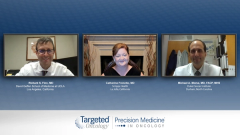
PD-1/PD-L1 Antibodies and VEGF Inhibitors in HCC
Episodes in this series

Richard S. Finn, MD: Now, the big change in all of oncology, and I would say even more recently in liver cancer, has been the impact of PD-1 and PD-L1 agents. Most recently, we saw some of the data with atezolizumab and bevacizumab. That’s based on the science of targeting PD-1, PD-L1, and VEGF. Michael, again, leaning on some of your preclinical experience, could you describe the background for targeting these 2 pathways?
Michael A. Morse, MD, FACP, MHS: The interesting observation across malignancies, as you pointed out, is there can be tumors that frequently have T-cell infiltration. Those T cells are poised to attack the PD-1, PD-L1 interaction. And whether that PD-L1 is deployed by the tumor cells or other infiltrating immune cells, it prevents the T cells from being able to kill. It causes the T cells to be dysfunctional. And that could be relieved by a blockade, either at the PD-L1 or the PD-1 portion of the interaction.
What’s even more interesting, though, is that if you look at anti-VEGF strategies—whether it’s hitting the receptor, whether it’s finding VEGF—it seems to modulate the immune system as well. We actually did some work, as did others a number of years ago, looking at dendritic cells. These are the key stimulators of T cells in the body. We looked at whether their maturity level was changed by inhibiting some aspect of the VEGF pathway. Indeed, they do seem to be suppressed when there are high levels of VEGF. They mature. They’re more effective stimulators of T cells when you inhibit VEGF signaling. And so, there’s a rationale for combining an anti-VEGF strategy with immunotherapy. Obviously, that’s been borne out now in several malignancies.
Transcript edited for clarity.









































